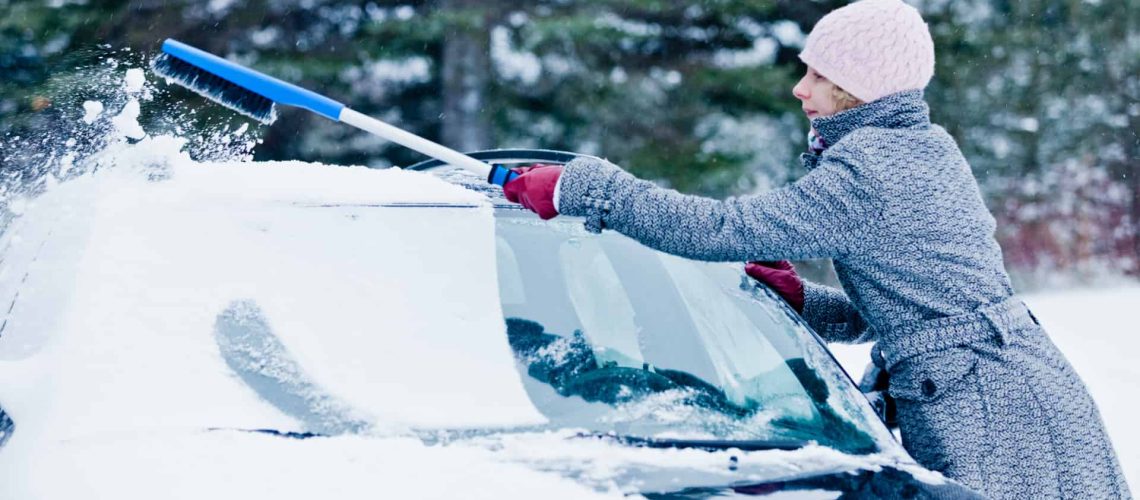Car dents can seemingly appear out of nowhere and come from a variety of sources. They not only lower the value and mar the appearance of your car, but they also can hide significant damage underneath them.
The best practice is always to fix any dents and dings right away. Otherwise, you risk the chance of more serious and expensive issues down the road.
This is particularly true during the winter months when the weather is colder. Low temperatures can boost the damage of car dents and winter elements like snow, ice, and hail can damage your vehicle further while also making driving conditions unsafe.
Let’s take a closer look at how cold weather affects car dents and what you can do to prevent serious issues.
Contents
Cars Are More Likely to Get Dents During Winter
Winter weather conditions make it easier to dent your vehicle during the colder months. The National Highway Traffic Safety Administration estimates that at least 21% of crashes are weather-related. This includes adverse weather like rain, sleet, snow, and icy pavement that are more common during the winter months. All these conditions provide the necessary factors to end up in a fender bender or major traffic accident.
Also, changes in temperature can make the frame of your vehicle predisposed to dents. Most metals contract as temperatures drops because the atoms in the metal will lower in kinetic energy. This causes them to take up less space, and as it contracts, the metal becomes more susceptible to damage.
This also means that dent repair during the colder months is much trickier. If you need to fix a dent during the winter months, you need to turn to a trusted and experienced professional.
Cold Weather Can Boost Damage of Dents
Not only does the cold weather predispose your metal frame to more damage, but these conditions also increase the impact of any dents, making it extra important to take care of any damage to your vehicle quickly.
While it’s always a good idea to address any car damage promptly, there are some additional risks to letting damage sit during the winter. The high levels of moisture during this time can increase the odds of rusting. Also, the roads being constantly caked with salts and chemicals can worsen paint damage. Leaving dents and other damage unrepaired through the winter months can result in much more extensive damage going forward.
Preparing Your Car for Winter Weather
There are precautions you can take to reduce the effects of harsh weather while lowering your risk of getting in a winter accident. Consider following these preventative winter maintenance tips to help prepare your vehicle for cold weather:
Repair any dents you have
It’s always a good idea to have your car’s dents repaired during the warmer months. This is because the metal or plastic that’s been dented will have to be warmed up first during the colder months before a proper repair can be made. Trying to make any dent repairs in below-freezing temperatures can seriously damage your vehicle’s paint, resulting in cracks and chips during the dent repair process.
Check your tires
Your tires need to be routinely checked throughout the year as they can be impacted by roads and the weather. You should check your tires’ tread, inflation, and overall condition before the weather turns cold.
Rotate your tires as well to ensure they wear evenly while you drive. You also need to make sure that your tires contain the proper tire pressure. Cold weather causes your tires to quickly lose air, which can be dangerous when harsh weather starts to make the roads slippery.
Repair any cracks or dings in your windshield
Like dents, it’s a good idea to have your windshield taken care of during the warmer weather because colder weather can make the problem worse. Cold weather can cause a cracked windshield to chip, fracture even more, or even break. Windshields that are free of cracks aren’t at risk of breaking during extremely cold weather.
Properly de-ice your vehicle
You should de-ice your vehicle as needed during the winter months. This will help you remove build-up and prevent dings and dents from occurring by having to scrape huge chunks of ice off your car. Shovels spell bad news for the body of vehicles. You want to do everything you can to keep your car ice-free.
Remove snow from the top of your car
Keeping the snow from the top of your car helps prevent snow from crashing down and causing damage to your vehicle. Chunks of ice are extremely sharp and can do a number on your car. Make sure to brush soft snow from the roof, hood, and trunk of your vehicle frequently during the colder months.
Fix Your Dents Now
Your best option is to get rid of all car dents and dings during the warmer months before the harsh winter weather arrives.
Despite all your efforts to protect your investment, dents are sometimes simply out of your control. Don’t worry — at JM Dent Repair, we know how much it means to you to get your car looking new again, and that’s why we’re trusted in the Lafayette area for affordable paintless dent repair.
Paintless dent repair eliminates the worry of a color mismatch or uneven fading and preserves your vehicle’s appearance and resale value. If you’re driving a leased vehicle, it also helps you avoid expensive “wear and tear charges” on your lease return. Contact us for a quote and see why we’re the best around.

